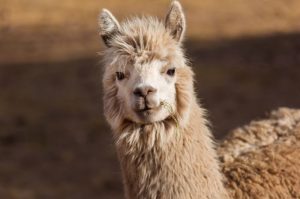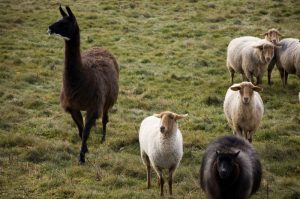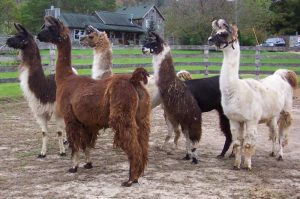
How You Can Use Llamas:
Llamas are not as popular as some other livestock animals like sheep, pigs, and cattle; however, they can be just as valuable. You may have seen llamas used as pack or companion animals, but did you know in many countries they are also used for their milk, meat, and other products?
What are llamas used for? Llamas have been providing humans with a wealth of benefits over the last 4,000 years. These include:
- Serving as pack animals
- Serving as companion animals
- Serving as livestock guardians
- Providing fertilizer
- Providing milk
- Providing meat
- Providing fleece
- Providing leather
- Providing tallow for candles
- Providing dried feces for fuel
Llamas are truly multi-use livestock and can benefit almost any homestead in some fashion. Keep reading to learn more about the numerous ways that llamas provide for us!
Where Did Llamas Originate?
Llamas originated in the mountains of Peru. They were domesticated in a harsh, windy climate, and have the hardiness and vigor to show for it. Llamas are still widely used in South America and serve various purposes. There are an estimated seven million llamas (and alpacas) currently in South America, and another 150,000 – 200,000 in the United States and Canada. While llamas were first imported into the United States in the 1800s to be used in zoo exhibits, they did not begin to gain popularity as livestock until the 1970s-1980s.
Llamas Serve As Pack Animals
The most common benefit that llamas provide is their use as pack animals. Llamas are incredibly strong for their size. An adult llama can reach a weight of up to 400 pounds, but can carry up to 25-30% of its body weight (for longer stretches, reduction to a load of 15-20% is recommended for the animal’s comfort and health). In addition to being able to carry a heavy load in relation to their body weight, llamas eat far less than other pack animals, and can go a longer period of time without water. Finally, llamas are fairly easy-going, and tend to be much less reactive and skittish than their equine counterparts.
There are many reasons that people use llamas as pack animals instead of horses or mules. They are commonly used in nomadic regions to carry a family’s belongings from one site to the next. They are also used by backpackers and hikers, to carry tents and supplies from one destination to another.
Llamas Serve As Companion Animals
Almost all livestock live happiest in groups or herds, and because of their easy-going disposition, llamas can make great companion animals. Because of the llama’s size and friendliness, this can benefit horses and donkeys the most. While they may at first act indifferent toward one another, it is likely you will soon find them grazing together and protesting when they are apart. For one reason or another, some horses and donkeys find it difficult to live with others of their kind. In these situations, the llama may be able to provide the companionship the equines need, without the perceived threat or challenge that another horse or donkey would elicit.
Llamas Serve As Livestock Guardians

Llamas can serve as effective guardians to other smaller livestock. Many goat and sheep keepers will keep a livestock guardian animal to defend the herd or flock against coyotes, bobcats, and other potential predators. These guardians are most commonly dogs, donkeys, or llamas. Llamas are very territorial, and are not as flighty as other prey animals. They are more likely to warn other animals when they perceive a threat, and then confront or chase off the predator. They can also make the livestock more comfortable, as some small ruminants may not be able to relax living with a large dog, but would be at ease grazing with a llama.
To learn about other popular livestock guardian animals, check out my article What Are the Best Livestock Guardian Animals?
Llamas Provide Fertilizer
Llama manure makes excellent fertilizer for the garden, and without the negative attributes of other livestock manure. It is considered a “cool” manure which means that it is lower in nitrogen. It can be applied to the garden fresh as opposed to needing to be composted first. Also, it has very little (or no) odor, making it more appealing to the gardener than working with bovine or other manure. Lastly, it is easy to collect; llamas defecate communally, in specific areas, so to collect llama manure you does not need to scour the entire field. It is also rich in phosphorus, potassium, and nitrogen, making it an excellent fertilizer for almost any plant.
Llamas Provide Milk
In some countries, llamas are used for their milk. Llamas can produce an average of two liters of milk per day, but there are some caveats. The first is that their teats are short, making it more difficult for humans to milk them. The second is that their udders have a smaller capacity than the udders of cows or goats, meaning they must be milked every few hours as opposed to twice daily like most animals used for milk. If you are willing to work around these challenges, you will be rewarded with a milk that is rich in both protein and fat.
Llamas Provide Meat
While not as commonly used for meat as cattle or pigs, llamas have provided meat to humans for thousands of years. It is high in protein but low in cholesterol, making it a healthy, lean game meat. It is said to taste like a combination of beef and mutton. It can be eaten fresh, but is also traditionally made into a jerky.
Llamas Provide Fleece
Like its relative the alpaca, llamas are commonly kept for their fiber. While not as soft or fine as the alpaca’s fleece, llama fibers are exceptionally durable and warm. It is also free of the lanolin that can cause allergies (in addition to the notable aroma) in sheep’s wool. It is versatile, used in a variety of applications, and comes in many different color variations. Because llamas continue to produce fleece, this is one commodity that you can continue to harvest from your llama year after year.
Llamas Provide Leather

If you are using your llamas for meat, it is ideal to use as much of the animal as possible. The skin of a dispatched llama can make excellent leather – in fact, some estimates are that due to the harsh conditions in which llamas originated, the leather made from their skin can be up to fifteen times stronger than leather made from the skin of cattle. If you plan to use your llamas for leather, you will want to read up on llama leather care – they will require a different method of dye and cleaning than traditional leather, and cannot be spot-cleaned.
Llamas Provide Tallow For Candles
Most of the candles sold in stores today are made with beeswax, soy wax, or paraffin wax. But in the past, most candles were made using tallow – another word for animal fat. This is another way to use as much of your llama’s processed carcass as possible; by rendering the fat, you can make an abundance of homemade candles so long as you have wicks and a few Mason jars. Tallow candles can keep for long periods of time, and the material is easy to work with. While most tallow candles are made from the fat of cattle or sheep, you can also make tallow candles from llama fat, chicken fat, pork lard, or even fish oil.
Llamas Provide Feces For Fuel
This one may have you scratching your head, but there is no typo here. For as long as llamas have been domesticated, their excrement has been used as a source of fuel. This is not only limited to llamas, either – in India, for example, cattle and buffalo feces are the most widely-used biological fuel. The term for this type of fuel is called “dry dung fuel”. It is commonly used as a source of heat and also for cooking. The practice has even gained popularity in the US, with more and more farmers seeking renewable and inexpensive sources of fuel. While it is not a clean energy and does contribute to pollution, the sustainability makes it relatively environmentally friendly when compared to some other sources of fuel.
Llamas Can Bring Several Benefits To A Homestead
As we’ve seen, llamas are not limited to their role as pack animals or companion animals. They are being used more often in the US as livestock guardians, bringing comfort to the livestock and protection from predators. They also provide many commodities both living (in the form of their dry dung fuel, their fiber, and their milk) as well as processed (for their meat, leather, and tallow). If you have the space and resources to keep a couple of llamas, there is no need to consider them as one-hit wonders – look outside the box and you will realize there are so many benefits that these animals can bring to your operation.
Alpacas and llamas have more similarities than just their looks; they also display many of the same behaviors! To get an idea of what your llama’s behavior may mean, check out my article Alpaca Behavior Guide: Alpaca Behaviors and What They Mean.
